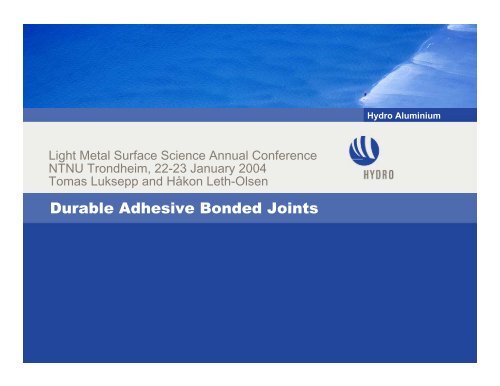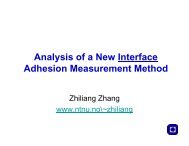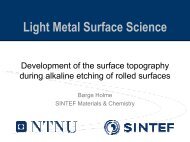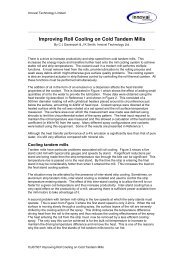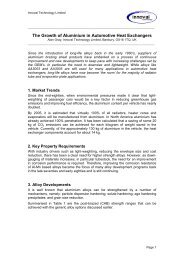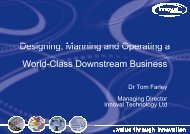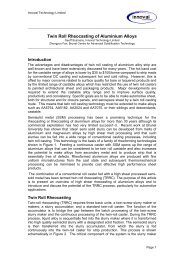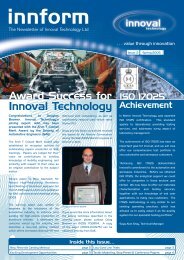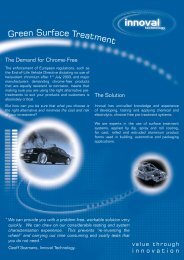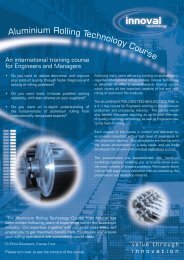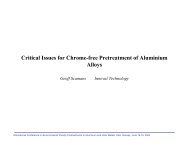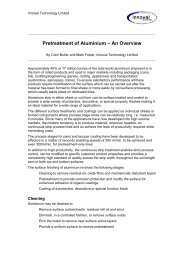Create successful ePaper yourself
Turn your PDF publications into a flip-book with our unique Google optimized e-Paper software.
Hydro Aluminium<br />
Light Metal Surface Science Annual Conference<br />
NTNU Trondheim, 22-23 January 2004<br />
Tomas Luksepp and Håkon Leth-Olsen<br />
Durable Adhesive Bonded Joints
Introduction<br />
The person who deals with lap shear testing of<br />
adhesive bonded joints has a problem with the<br />
environment!<br />
The human environment!<br />
Date: 2004-01-13 • Page: 2 • Hydro Aluminium
Introduction<br />
Maybe little of a general view<br />
Suspect tests performed by suspect<br />
individuals with suspect results!<br />
Why?<br />
The person can never give the answer YES, IT WORKS! without a but.<br />
To many parameters affects the results.<br />
No “buts” in industrial use.<br />
Date: 2004-01-13 • Page: 3 • Hydro Aluminium
Outline<br />
Test methods to establish durability confidence<br />
<br />
<br />
<br />
Lap shear testing, 5 years outdoor results<br />
Testing with road mud or salt solutions<br />
Environmental fatigue testing<br />
Summary / conclusions<br />
Date: 2004-01-13 • Page: 4 • Hydro Aluminium
Accelerated lap shear testing<br />
<br />
A ranking test, only qualitative<br />
<br />
Only a limited number of parameter can be compared in<br />
each matrix<br />
<br />
Rather complicated, experience required, expensive<br />
<br />
The ultimate lap shear ageing test does not exist<br />
<br />
Nevertheless, it simulates the real joint<br />
Date: 2004-01-13 • Page: 5 • Hydro Aluminium
Hydro, lap shear testing<br />
<br />
<br />
<br />
<br />
SWAAT, (Sea Water Artificial Acidified Test)<br />
– 49°C, cyclic, 30 min spray, pH 2.8-3.0, 90 min, 98% RH<br />
Outdoor, salt spray once a week, 45º south side<br />
Cassette underneath trailer, natural mud<br />
– Gothenburg – Raufoss, Norway on a daily base<br />
Trailer + Outdoor, on ground, no salt, no sun<br />
Initiation, 16 % HCl, 10 min<br />
Orientation<br />
Outdoor Trailer<br />
Date: 2004-01-13 • Page: 6 • Hydro Aluminium
Failure surfaces, after 1 year on trailer<br />
Example<br />
Extrusion, 6060.35<br />
Adhesive, Betamate XW1044-3<br />
Degreased Degreased + HCl Etched + HCl<br />
<br />
The Near Surface Active Region from thermo- mechanical<br />
processing has to be removed<br />
5 % 30 % 1 %<br />
Date: 2004-01-13 • Page: 7 • Hydro Aluminium
Amount of visual corrosion and/or delamination in percent of<br />
area for each lap shear specimen<br />
SWAAT Outdoor HCl + Outdoor Outdoor Outdoor Trailer HCl + Trailer HCl + Trailer +<br />
Surface 6 weeks 1 year 1 year 2,5 year 5 year 1 year 1 year Outdoor*,<br />
Adhesive 1 year + 1 year<br />
DEG XW1044-3 0 0 5 25 50 0 0 0 0 0 0 0 0 0 0 0 0 2 10 10 5 20 25 40 50 0 0 5 5 5 30 30 30 30 30 50 50 60 60 70<br />
DEG B 1494 0 0 0 0 10 0 0 0 10 10 0 0 0 0 10 0 0 0 0 20 0 1 10 10 30 0 0 0 5 5 30 30 30 30 30 50 70 80 85 95<br />
DEG XD4600 70 80 80 90 100 0 0 5 5 5 1 1 5 5 10 0 0 0 10 20 10 20 20 40 40 15 15 15 15 15 50 75 85 100 100<br />
DEG WC2310 0 0 2 2 2 15 15 15 20 20 10 10 20 30 40 0 5 5 5 5 50 50 50 50 50 40 90 95 95 95<br />
ETCH XW1044-3 0 0 0 2 25 0 0 0 0 0 0 0 0 0 2 0 0 0 0 1 0 0 0 0 1 0 0 0 1 1 2 2 5 10 20<br />
ETCH B 1494 0 0 0 0 0 0 0 0 0 0 0 0 0 0 0 0 0 0 0 10 0 0 0 1 1 0 0 0 0 0 0 0 0 1 1 0 1 2 5 5<br />
ETCH XD4600 0 0 1 2 30 0 0 0 0 0 0 0 0 0 0 0 0 0 5 5 0 0 0 1 5 0 0 0 0 0 0 0 5 10 25 0 0 1 1 2<br />
ETCH WC2310 80 100 100 100 100 0 0 0 0 0 0 0 0 0 0 30? 30? 30? 0 0 0 0 0 0 0 0 0 0 1 2 5 10 10<br />
ETCH XB5315 0 1 1 2 2 0 0 0 0 0 0 0 0 0 0 0 0 0 0 0 0 0 0 0 0<br />
ETCH AV119 0 0 0 10 20 0 0 0 0 0 0 0 0 0 0 0 0 0 5 10 10 10 15 30 50<br />
ETCH DP490 50 50 85 100 100 0 0 0 0 0 0 0 0 0 0 1 1 1 1 1 * no salt, no sun<br />
ETCH 3M 5047 0 0 0 0 0 0 0 0 0 0 1 1 1 1 1<br />
TiZr XW1044-3 0 0 0 5 10 0 0 0 0 0 0 0 0 0 2 0 0 0 5 5 0 0 0 5 30 0 0 0 1 1 0 0 1 1 1 10 15 20 25 60<br />
TiZr B 1494 0 0 0 0 0 0 0 0 0 0 0 0 0 0 0 0 0 0 0 0 10 10 20 25 40 0 0 0 0 1 1 1 1 1 10 10 20 20 30 75<br />
TiZr XD4600 5 30 30 30 50 0 0 0 0 0 0 0 0 0 0 0 0 0 2 2 0 0 0 0 0 0 0 10 10 10 15 25 40 40 50<br />
TiZr WC2310 0 0 0 0 0 1 1 2 2 2 0 0 2 10 10<br />
SAA XW1044-3 0 0 0 0 0 0 0 0 0 0 0 0 0 0 0 0 0 0 0 0<br />
SAA B 1494 0 0 0 0 0 0 0 0 0 0 0 0 0 0 0 0 0 0 0 0 0 0 0 0 0 0 0 0 0 0 0 0 0 0 0 0 0 0 0 0<br />
SAA XD4600 0 0 0 0 0 0 0 0 0 0 0 0 0 0 0 0 0 0 0 1 0 0 0 0 10 0 0 0 0 10 0 0 0 0 0 0 0 0 0 0<br />
SAA XB5315 0 0 0 0 0 0 0 0 0 0 0 0 0 0 0 0 0 0 0 0 0 0 0 0 0 0 0 0 0 0 0 0 0 0 0 0 0 0 0 0<br />
ROCA XD4600 1 1 1 1 1 0 0 0 0 0 0 0 0 0 0 0 0 0 0 0<br />
ROCA WC2310 5 5 15 15 25 0 0 0 0 0 0 0 0 0 0 0 0 0 0 0 0 0 0 0 0<br />
PY XD4600 90 90 90 90 90 0 10 30 30 50 85 90 95 95 100 60 80 90 100 100 10 25 25 25 40 70 80 80 90 100 95 100 100 100 100<br />
PY WC2310 0 0 0 0 2 2 2 2 2 5 5 5 10 15 15 5 5 5 5 5 50 60 60 60 70 50 60 100 100 100<br />
2-k adhesive 1 - 5 % 5 - 15 % 15 - 100 %<br />
Date: 2004-01-13 • Page: 8 • Hydro Aluminium
Main ageing notes<br />
<br />
<br />
<br />
<br />
<br />
Outdoor, with salt spray<br />
1 year, not selective enough<br />
Initiated corrosion may not propagate<br />
Trailer<br />
At least 2 times as corrosive than accelerated outdoor.<br />
Trailer + outdoor storage<br />
Condition for corrosion propagation is present<br />
SWAAT<br />
Proper ranking?<br />
Mainly a corrosion failure mechanism in service<br />
Adhesives, relatively small differences<br />
Surfaces, large differences<br />
Detailed test results will be available via the Automotive Manual, European Aluminium Association in<br />
the appendix report from working group GTP 4, General Test Procedures- Bond durability<br />
Date: 2004-01-13 • Page: 9 • Hydro Aluminium
Road mud effects<br />
<br />
Why is the trailer test worse?<br />
The mud provided chlorides and extended time of wetness.<br />
Reduce dilution/ washing effects.<br />
Significant acidification. Dependant on salt composition.<br />
Date: 2004-01-13 • Page: 10 • Hydro Aluminium
Mud weight vs. Relative humidity<br />
Normalised weight<br />
1,1<br />
1<br />
Mud incl. AlCl3 Mud 5x'Maritime'<br />
Visually wet<br />
0,9<br />
0,8<br />
0,7<br />
0,6<br />
0,5<br />
0 10 20 30 40 50 60 70 80 90 100<br />
Relative humidity (%)<br />
’Maritime’ salt solution<br />
from Dutch roads<br />
Species<br />
Concentration (g/l)<br />
NaCl 22,6<br />
MgCl 2 x 6H 2 O 7,8<br />
Na 2 SO 4 4,0<br />
CaCl 2 1,4<br />
KCl 1,0<br />
MgSO 4 x 7H 2 O 0,05<br />
Ca(NO 3 ) 2 0,04<br />
NH 4 NO 3 0,04<br />
The mud is made of sea sand, kaolin and salt solution<br />
The point of deliquescence for NaCl at RT is ~76 %, MgCl 2<br />
and CaCl 2<br />
~30 %<br />
Date: 2004-01-13 • Page: 11 • Hydro Aluminium
Composition and pH of the salt solutions used<br />
to produce the five muds.<br />
Species Mud 1<br />
Neutral<br />
Mud 2<br />
Acid<br />
Mud 3<br />
Maritime<br />
Mud 4<br />
Acid Mari.<br />
Mud 5<br />
Trailer<br />
Water (g) 300 300 300 300 300<br />
NaCl 50 47.5 33.9 33.9 39.43<br />
AlCl 3<br />
x 6H 2<br />
O - 2.5 - Added till pH 0.46<br />
4<br />
MgCl 2<br />
x 6H 2<br />
O - - 11.7 11.7 1.32<br />
CaCl 2<br />
- - 2.1 2.1 5.91<br />
Na 2<br />
SO 4<br />
- - 6.0 6.0 -<br />
KCl - - 1.5 1.5 1.08<br />
Mg 2<br />
SO 4<br />
x 7H 2<br />
O - - 0.075 0.075 -<br />
Ca(NO 3<br />
) 2<br />
- - 0.06 0.06 -<br />
NH 4<br />
NO 3<br />
- - 0.04 0.04 -<br />
FeCl 2<br />
x 4H 2<br />
O - - - - 0.25<br />
pH 7.1 3.2 5.5 4.0 4.2<br />
Date: 2004-01-13 • Page: 12 • Hydro Aluminium
pH values measured for the salt solutions and<br />
the muds<br />
Mud/solution no. pH in salt solution pH in mud slurry<br />
1 7.1 3.8<br />
2 3.2 3.1<br />
3 5.5 3.9<br />
4 4.0 3.6<br />
5 4.2 3.7<br />
<br />
<br />
<br />
Technical difficult to conduct pH measurement underneath a ‘dry’ mud film.<br />
Clean sand might be washed in HCl<br />
Kaolin affects pH<br />
Date: 2004-01-13 • Page: 13 • Hydro Aluminium
pH for salt layers from solutions 3, 4 and 5 at<br />
two RH levels<br />
Mud/Solution no. 60 % RH 75 % RH In solution<br />
Solution 3 4.7 5.2 5.5<br />
Solution 4 2.6 4.2 4.0<br />
Solution 5 2.9 3.7 4.2<br />
<br />
<br />
<br />
Concentration and pH changes with relative humidity<br />
Qualitative measurements<br />
At 60 % RH the salt layer on the electrode appeared solid,<br />
whereas at 75 % RH it appeared liquid.<br />
Date: 2004-01-13 • Page: 14 • Hydro Aluminium
Test conditions<br />
<br />
Test plates were coated with 1-2 mm mud and placed horizontal<br />
in a 40 o C humidity cabinet for 4 weeks<br />
<br />
48 hours humidity cycle:<br />
24 hours at 85% RH and<br />
24 hours at 50% RH<br />
Pitted surfaces of etched AA6060<br />
Date: 2004-01-13 • Page: 15 • Hydro Aluminium
Tested substrates<br />
Designation Supplier Alloy Surface treatment<br />
6060 etched Hydro Aluminium AA6060 NaOH etched (5 µm)<br />
6060 anodised Hydro Aluminium AA6060 Etched and H 2<br />
SO 4<br />
anodised (4-7 µm)<br />
6016 etched Pechiney AA6016 NaOH etched (5 µm)<br />
6016 Ti-Zr cc Pechiney AA6016 Ti-Zr based CC (Gardobond X4591)<br />
5754 etched Pechiney AA5754 NaOH etched (5 µm)<br />
5754 Ti-Zr cc Pechiney AA5754 Ti-Zr based CC (Gardobond X4591)<br />
5018 etched Corus AA5018 NaOH etched (5 µm)<br />
5018 Ti cc Corus AA5018 Ti based CC (Alodine 2010)<br />
Date: 2004-01-13 • Page: 16 • Hydro Aluminium
Average weight loss for the different alloys and pretreatments<br />
after four weeks exposure with different muds in the humidity<br />
cabinet.<br />
Mud 1 Mud 2 Mud 3 Mud 4 Mud 5<br />
20<br />
18<br />
16<br />
14<br />
12<br />
10<br />
8<br />
6<br />
4<br />
2<br />
0<br />
Weightloss [mg/ (cm 2 year)]<br />
6060 / etched<br />
6060 / anodised<br />
6016 / etched<br />
6016 /Ti+Zr cc<br />
5754/ etched<br />
5754 /Ti+Zr cc<br />
5018 / etched<br />
5018 / Ti cc<br />
Date: 2004-01-13 • Page: 17 • Hydro Aluminium
Average pit density after four weeks exposure<br />
Mud 1 Mud 2 Mud 3 Mud 4 Mud 5<br />
90<br />
80<br />
70<br />
60<br />
50<br />
40<br />
30<br />
20<br />
Pit density [cm -2 ]<br />
0<br />
10<br />
6060 / etched<br />
6060 / anodised<br />
6016 / etched<br />
6016 / Ti+Zr cc<br />
5754/ etched<br />
5754 / Ti+Zr cc<br />
5018 / etched<br />
5018 / Ti cc<br />
Date: 2004-01-13 • Page: 18 • Hydro Aluminium
Average pit depth after four weeks exposure.<br />
Mud 1 Mud 2 Mud 3 Mud 4 Mud 5<br />
200<br />
150<br />
100<br />
50<br />
Pit depth [m]<br />
0<br />
6060 / etched<br />
6060 / anodised<br />
6016 / etched<br />
6016 / Ti+Zr cc<br />
5754/ etched<br />
5754 / Ti+Zr cc<br />
5018 / etched<br />
5018 / Ti cc<br />
Date: 2004-01-13 • Page: 19 • Hydro Aluminium
Mud test, summary<br />
<br />
The composition of a road mud affects the<br />
corrosion behaviour.<br />
<br />
The effect has to be understood to better<br />
correlate lab tests with in-service behaviour.<br />
No one wants mud as a parameter in standardised<br />
tests.<br />
Date: 2004-01-13 • Page: 20 • Hydro Aluminium
Requirements on a corrosion screening test<br />
<br />
<br />
<br />
<br />
<br />
Simple qualitative screening before advance testing<br />
Ranking ability<br />
Fast and simple<br />
A large number of specimen permutations<br />
A few graded assessment scale would be enough<br />
Date: 2004-01-13 • Page: 21 • Hydro Aluminium
Salt solution corrosion test<br />
<br />
<br />
Small specimens partly coated with adhesive<br />
Horisontal exposure with almost saturated salt solutions<br />
Duration: 3 months<br />
Temperature: 40°C<br />
Humidity: 12 hours cycle;<br />
6 h at 85% RH, 6 h at 50% RH.<br />
<br />
Evaluation of corrosion on the open surface and under cutting the<br />
adhesive (delamination).<br />
Date: 2004-01-13 • Page: 22 • Hydro Aluminium
Salt solutions<br />
Salt no.<br />
1<br />
2<br />
3<br />
4<br />
5<br />
6<br />
7<br />
Salt solutions<br />
Pure NaCl<br />
95% (wt) NaCl + 5% AlCl 3<br />
“Maritime solution”<br />
“Maritime solution” + AlCl 3 to pH 4<br />
“Mud 5 solution” (artificial trailer)<br />
Pure CaCl2<br />
Pure MgCl2<br />
Measured pH<br />
5.4<br />
2.3<br />
4.5<br />
3.8<br />
2.5<br />
3.6<br />
4.9<br />
Almost saturated solutions when applied<br />
pH measurement on diluted solutions 1:9<br />
Date: 2004-01-13 • Page: 23 • Hydro Aluminium
Example of screening of systems<br />
12 weeks exposure with salt 4, “Maritime solution” + AlCl 3 to pH 4<br />
4<br />
Rank<br />
Adhesive<br />
delamination<br />
Corrosion on<br />
bare surface<br />
Ranking<br />
3<br />
2<br />
1<br />
Delamination<br />
Corrosion<br />
0<br />
1<br />
2<br />
0%<br />
0-5%<br />
5-15%<br />
No corrosion<br />
No surface<br />
corrosion, some<br />
pitting corrosion<br />
Surface<br />
corrosion, no or<br />
very limited<br />
pitting<br />
0<br />
1 2 3 4 5 6 7 8<br />
Material No.<br />
Systems responds differently and ranking is obtained.<br />
3<br />
4<br />
15-30%<br />
>30%<br />
Surface and<br />
pitting corrosion<br />
Surface<br />
corrosion and<br />
extensive pitting<br />
and general<br />
corrosion (><br />
30% of surface)<br />
Date: 2004-01-13 • Page: 24 • Hydro Aluminium
Tested materials<br />
<br />
<br />
Adhesive<br />
<br />
Heat curing epoxy, XD 4600, Dow<br />
Surface<br />
Hot AC (alternated current) anodised 3105 (Material 2)<br />
– Iron rich metal, reactive surface layer converted?<br />
5754 passivated (Material 4)<br />
– ?<br />
Date: 2004-01-13 • Page: 25 • Hydro Aluminium
3105 H44 Hot AC SAA, 3 months exposure<br />
2 Acid NaCl 5 Art. trailer 6 CaCl 2 4 Acid Maritim<br />
pH = 2.3 pH = 2.5 pH = 3.6 pH = 3.8<br />
3 Maritim 7 MgCl 2 1 NaCl<br />
pH = 4.5 pH = 4.9 pH = 5.4<br />
Blisters from<br />
cut edge<br />
SWAAT and<br />
service<br />
performance?<br />
Date: 2004-01-13 • Page: 26 • Hydro Aluminium
5754 passivated, 3 months exposure<br />
2 Acid NaCl 5 Art. trailer 6 CaCl 2 4 Acid Maritim<br />
pH = 2.3 pH = 2.5 pH = 3.6 pH = 3.8<br />
Salt 3 vs 1 in a<br />
accelerated<br />
lap shear test?<br />
3 Maritim 7 MgCl 2 1 NaCl<br />
pH = 4.5 pH = 4.9 pH = 5.4<br />
Date: 2004-01-13 • Page: 27 • Hydro Aluminium
Screening of salt solutions<br />
12 weeks exposure of 3105 hot AC (2) and 5000 (4)<br />
Shorter test times could be enough<br />
4<br />
4<br />
Corrosion Ranking<br />
3<br />
2<br />
1<br />
Delamination ranking<br />
3<br />
Surface 2 2<br />
Surface 4<br />
1<br />
Surface 2<br />
Surface 4<br />
0<br />
1 2 3 4 5 6 7<br />
0<br />
1 2 3 4 5 6 7<br />
Salt No.<br />
Salt No.<br />
Date: 2004-01-13 • Page: 28 • Hydro Aluminium
Summary, salt solution tests<br />
<br />
Acidification is a most important acceleration factor.<br />
<br />
Relevant test conditions will vary with market place.<br />
<br />
A very simple and fast test with ranking ability for both<br />
initiation and propagation has been demonstrated, suitable?<br />
<br />
”Massive screening could be made relatively cheap”<br />
– Substrate initiation and undercutting propagation<br />
– Screening of environmental conditions<br />
– Screening of many systems at fixed relevant conditions<br />
Date: 2004-01-13 • Page: 29 • Hydro Aluminium
Cyclic stress testing with environmental load,<br />
principles<br />
Reinforced Double Cantilever Beam, RDCB<br />
Crack-<br />
Length<br />
Reinforcements bonded on,<br />
prevents yielding<br />
With constant<br />
deformation<br />
Crack growth rate<br />
Log da/dN (mm/cycle)<br />
"Wet"<br />
"Dry"<br />
Gc, static<br />
Adhesive<br />
fracture<br />
energy<br />
Gth<br />
Log Gmax<br />
Loadcycles<br />
Load measures => crack length<br />
Maximum value of strain energy<br />
release rate during a fatigue cycle<br />
Date: 2004-01-13 • Page: 30 • Hydro Aluminium
Baseline testing, ambient conditions<br />
1,E-02<br />
Dry testing of adhesive XD4600<br />
da/dN [mm/cycle]<br />
<br />
1,E-03<br />
1,E-04<br />
1,E-05<br />
1,E-06<br />
1,E-07<br />
Ti/Zr, x4707<br />
Etch ’Short’<br />
Degreased<br />
X4707 - XD4600<br />
Etched HRE- XD4600<br />
Degreased - XD4600<br />
Etched RDK ’Long’ - XD4600<br />
10,00 100,00 1 000,00<br />
G max [J/m 2 ]<br />
The surface pretreatment affects fatigue resistance<br />
Date: 2004-01-13 • Page: 31 • Hydro Aluminium
Failure modes<br />
Start of test, End of test<br />
Deagreased<br />
Oxide failure<br />
Ti/Zr, x4707<br />
Initial crack, PTFE shims<br />
Coating failure<br />
Date: 2004-01-13 • Page: 32 • Hydro Aluminium
Failure modes (2)<br />
Interfacial failure<br />
’Short’<br />
etch<br />
’Long’<br />
etch<br />
Cohesive failure<br />
Date: 2004-01-13 • Page: 33 • Hydro Aluminium
TEM, Altered layer on etch (1)<br />
At microtoming the<br />
first altered layer<br />
exhibit a waved crack,<br />
indicating changed<br />
mechanical properties<br />
Long etching time<br />
and no desmutting<br />
At both dry and wet<br />
fatigue testing, crack<br />
Propagation occurs in<br />
the bulk of the adhesive<br />
Mineral fillers are<br />
magnitudes larger than<br />
the thixotropy agent<br />
(fused silica)<br />
Aluminium<br />
Adhesive<br />
Gunnar Pettersson, Sintef<br />
5 µm<br />
Date: 2004-01-13 • Page: 34 • Hydro Aluminium
TEM, Altered layer on etch (2)<br />
Long etching time and no desmutting<br />
BULK<br />
Atom %<br />
C O Mg Al Si<br />
75 12 0 0 13<br />
A2<br />
A1<br />
Aluminium<br />
Gunnar Pettersson, Sintef<br />
Adhesive<br />
XD4600<br />
5 µm<br />
92 6 0 1 1<br />
42 15 17 18 8<br />
Altered layer<br />
1. Adhesive and oxides<br />
mixed as a micro<br />
composite<br />
2. Polymer rich layer,<br />
with less thixotropy<br />
agent<br />
Cohesive fatigue failure<br />
Date: 2004-01-13 • Page: 35 • Hydro Aluminium
TEM, Altered layer on etch (3)<br />
’Short’<br />
etch<br />
Aluminium<br />
At the interface<br />
10 m into the adhesive<br />
Interfacial<br />
fatigue<br />
failure<br />
200 nm 200 nm<br />
Altered layer<br />
A1, ’composite’<br />
A2, ’polymer’<br />
’Long’ etch time<br />
4 m, full coating<br />
Distinct, Si free layer<br />
’Short’ etch time<br />
1 m, partially ’nothing’<br />
Reduced amount of Si particles<br />
Date: 2004-01-13 • Page: 36 • Hydro Aluminium
Summary, environmental fatigue testing<br />
<br />
A good tool for testing bond system durability performance with<br />
respect to weak boundary layers and wet adhesion<br />
(Supported by surface characterisation techniques)<br />
<br />
Quantitative measurements<br />
Data for life predictions<br />
Not suitable for corrosive environments<br />
Fatigue is generally not an issue<br />
for a bonded automotive designs!<br />
Date: 2004-01-13 • Page: 37 • Hydro Aluminium
The toolbox for confident durability testing<br />
<br />
Current screening, lap shear tests<br />
Corrosion<br />
Wet adhesion<br />
Relevant configuration<br />
Many different tests<br />
Field correlation ??<br />
Verification<br />
<br />
<br />
New screening tests, (mud) or salt solution tests?<br />
Corrosion propagation<br />
Fast and simple<br />
Corrosion initiation<br />
Advanced testing, environmental fatigue, DCB specimens<br />
Weak boundary layers<br />
Quantitative test<br />
Wet adhesion<br />
Date: 2004-01-13 • Page: 38 • Hydro Aluminium
Conclusion<br />
<br />
Durable bonded joints requires good<br />
Wet adhesion<br />
Corrosion resistance<br />
<br />
Tools for durability assessments are available.<br />
<br />
Durability confidence for bonded joints will be achieved.<br />
Date: 2004-01-13 • Page: 39 • Hydro Aluminium


